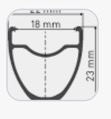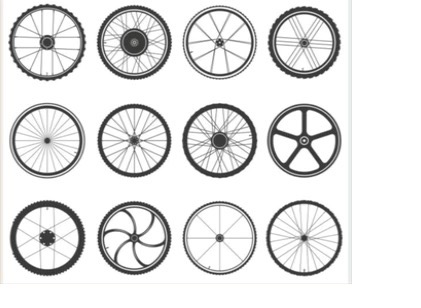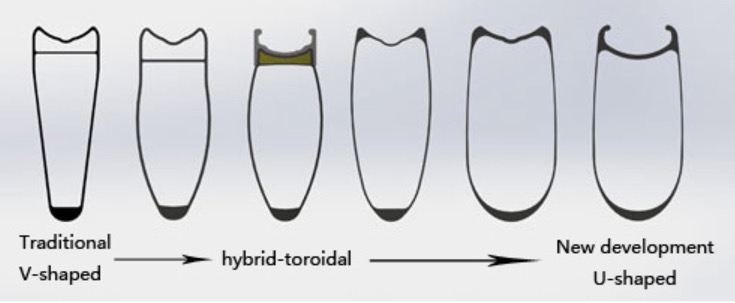
Bicycle Rims: A Comprehensive Guide to Tubeless and Clincher Rims

The DT Swiss tubeless rim shown on the left is an aluminum rim, which they call a high dome. The open top is where the rim tape goes in the dished-out area. The little rim seals at the top are the section that grips the tires. Tubeless tires must often be glued in place if the tire does not have a wire bead around the sidewall where the tire mounts. Notice this is a very narrow tire. Even the Tour De France pro are moving away from the 23mm tire and going to 28 – 32 mm. The have found the ride to be superior and the rolling resistence is less.
When we consider the choices of rims, tubes or tubeless tires and rims, materials like carbon fiber or aluminum. These images come to mind of racing, touring or just relaxing rides through the countryside on our favorite trail. Regardless of our riding style or frequency rims and tires are where the rubber meets the road. I always wanted to say that.
Choices are as vast as the stars until you understand the rims and applications. Lighter is usually a road racer, coupled with tubeless tires. Carbon fiber depending on width can be either. Wider is usually a road or touring trike. The evolution of tires has change how we think of bicycle tires. The information below should help clear the dust so you can make the right choice for your riding style.

Bicycle rims are an essential component of any bicycle. They not only support the weight of the rider and the bike but also greatly impact the overall performance and safety. When it comes to road bikes, two popular options are tubeless and clincher rims. Additionally, the choice between carbon fiber and aluminum rims is a topic of great debate, especially pertaining to durability, safety at higher speeds, and sidewall preferences for tires. In this article, we will delve into the fascinating world of bicycle rims, exploring the various aspects that cyclists should consider when choosing the ideal set for their road bike.
Clincher Rims with Tubes: The Traditional Choice
Let’s begin by unraveling the traditional choice of clincher rims with tubes. Clincher rims are an industry standard, and they accommodate tires that have a separate inner tube. This type of rim offers several advantages, including ease of installation and maintenance. Should you experience a puncture on the road, replacing the inner tube is a relatively straightforward process. Moreover, the vast availability of clincher tires on the market makes it easier to find a suitable option for your road bike.
However, clincher rims with tubes also have their drawbacks. The presence of a tube introduces an additional layer that can increase rolling resistance and add weight to the overall bike setup. Additionally, clincher rims are generally considered less aerodynamic compared to the tubeless counterparts. Nonetheless, for riders who prioritize convenience and affordability, clincher rims with tubes remain a popular choice.
Tubeless Rims: The Future of Road Cycling

Hybrid Toroidal? I knew you were wondering what that meant—very little excitement about that word. The blue donut below, on the bottom right, is a Toroidal design; the only difference on the bicycle rim is they don’t use it as a circle. It means wrapping wire tightly side by side to form a circle. Carbon fiber strands take the place of the wire yet are dense and create the strength of the rim’s sidewall and ground surface tread utilized on a carbon fiber rim.

Changes that have been occurring in recent years.
“In recent years, tubeless rims have gained significant traction as a viable alternative to traditional clincher rims with tubes. Tubeless rims allow you to ride without an inner tube, as the tire creates an airtight seal against the rim. This setup offers notable advantages, such as reduced rolling resistance, improved puncture resistance, and enhanced ride quality. With no tube, riders can also run lower tire pressures, providing better traction and comfort on various road surfaces.”
Tubeless rims, however, require specific tubeless-ready tires, which have a bead that securely attaches to the rim. While the market for tubeless tires has expanded considerably, the range of options might still be narrower than that of clincher tires. Furthermore, the initial setup of tubeless rims can be more complicated, requiring the use of tubeless valves, sealant, and careful installation to prevent air leaks. Nevertheless, as technology continues to advance, tubeless rims are becoming an increasingly enticing option for road cyclists seeking improved performance and reduced puncture-related inconveniences.
Carbon Fiber Rims vs. Aluminum Road Rims: Durability and Safety
When it comes to selecting a rim material, two leading contenders are carbon fiber and aluminum. Carbon fiber rims have gained immense popularity due to their exceptional strength-to-weight ratio. They are known for providing a smoother ride quality while significantly reducing weight, which can positively impact acceleration and climbing. Carbon fiber rims also exhibit great durability when properly manufactured, with high-end models offering impressive strength and the ability to withstand rough road conditions.
On the other hand, aluminum road rims are generally regarded as more affordable and forgiving than their carbon counterparts. While they may not provide the same lightweight advantage as carbon fiber, aluminum rims offer increased durability and a stiffer ride, particularly for heavier riders or those seeking maximum power transfer. Additionally, aluminum rims are less prone to catastrophic failure, making them potentially safer at higher speeds or in cases of rough impacts.
Side Wall Preferences and Requirements
Another crucial aspect to consider when choosing bicycle rims is the sidewall requirements for the specific tire and rim combination. Carbon fiber rims often require tire sidewalls that can handle the higher pressures associated with road biking. Manufacturers usually specify the recommended tire pressure range and sidewall construction to prevent blowouts or tire failures.
For Aluminum Bicycle Rims, the tire sidewall requirements may be more flexible due to their ability to handle a wide range of tire pressures. However, matching the tire and rim combinations appropriately is essential to ensure optimal performance and safety. Consulting the manufacturer’s guidelines and recommendations is advised when choosing tires for both carbon fiber and aluminum rims.
In conclusion:
Selecting the right bicycle rims is a crucial decision for any road cyclist. Considerations such as tubeless or clincher design, the choice between carbon fiber and aluminum, durability, safety at higher speeds, and sidewall preferences all play significant roles in determining the ideal rim for your road bike. Keeping these factors in mind and conducting thorough research will help you make an informed decision that aligns with your specific needs and riding style, ensuring you enjoy a safe and smooth cycling experience.
